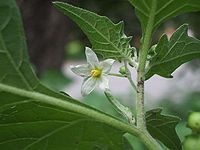
Photo from wikipedia
Carbon dioxide (CO2) as one of the main factors driving climate change is known to increase grapevine growth and yield and could, therefore, have an impact on the fruit quality… Click to show full abstract
Carbon dioxide (CO2) as one of the main factors driving climate change is known to increase grapevine growth and yield and could, therefore, have an impact on the fruit quality of vines. This study reports the effects of elevated CO2 (eCO2) on berry development and bunch structure of two grapevine cultivars (Vitis vinifera L. cvs. Riesling and Cabernet Sauvignon) within the VineyardFACE (Free-Air Carbon Dioxide enrichment) experiment, using must analysis and non-invasive fluorescence sensor technology. Berry development was examined on five dates over three consecutive years by analyzing total soluble solids (TSS), pH, total acidity, organic acids, nutrition status, and non-invasive Multiplex measurements. Before harvest, secondary bunches were collected to examine bunch and berry parameters. Results showed that eCO2 had little impact on berry composition of Riesling and Cabernet Sauvignon during berry development, which could be related to bunch structure or single berry weight within single seasons. Elevated CO2 (eCO2) did not result in modified TSS accumulation during ripening but was directly related to the chlorophyll index SFR_R. Higher single berry weights (SBW), higher malic acid (MA), and lower tartaric acid (TAA) were examined at some stages during development of berries under eCO2 levels. Our study provides evidence that eCO2 did alter some bunch and berry parameters without a negative impact on fruit quality.
Journal Title: Applied Sciences
Year Published: 2020
Link to full text (if available)
Share on Social Media: Sign Up to like & get
recommendations!